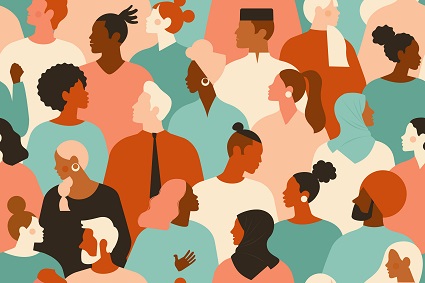
Summer 2021
Did Communication Inequities Worsen During the COVID-19 Pandemic? What Is There to Learn?
Adati Tarfa, PharmD, MS✉; Patricia Rodriguez Espinosa, PhD, MPH✉; and Kassandra I. Alcaraz, PhD, MPH✉; Health Equity SIG

The COVID-19 pandemic has been marked by considerable misinformation spread and rapid changes in messaging. Examples include evolving guidelines around COVID-19 treatment1, testing for asymptomatic individuals2, and shelter-in-place mandates, among others. These were accompanied by changes in messaging regarding travel restrictions, mode of transmission, and safety precautions. Notably, recently, while the uneven distribution of vaccines was occurring across the country, with marginalized communities having less access to the vaccine during the initial rollout, the Centers for Disease Control and Prevention (CDC) revised guidelines to allow for vaccinated people to be mask-less in public spaces3. The rapid change in COVID-19-related information and guidelines continues to present a challenge in ensuring that information reaches and benefits all, particularly populations who have been overburdened by the pandemic.
Historical inequities in access to and availability of factual health information have resulted in some populations facing more barriers to accessing quality information. Although studies have not examined the direct impact of COVID-19 misinformation and information access on health outcomes, it is evident that the pandemic has disproportionately impacted marginalized communities who historically have unequal access to health information. Distrust coupled with barriers to accessing information have potentially contributed to disparities in vaccination rates, particularly among Black Americans and Latinx communties4,5. With the advent of going back to the “new normal,” there is a need to examine how to improve COVID-19 messaging and other health communication to be more inclusive.
Hurdles to equitably accessing health information include language barriers and issues with health information translation, technology access, and health literacy. The resulting challenges include the following:
- Time: During a pandemic, time is of the essence, yet underserved communities tend to lag in obtaining health information. For example, signs for vaccination in Spanish, appointment hotlines, or websites in diverse languages are just rolling out in underserved areas while English-speaking communities have had vaccine information in readable texts for months in advance.
- Resources: The resources needed to translate and spread information can also present additional barriers such as funding to produce and distribute the information in the appropriate language. This responsibility tends to fall on already overburdened community organizations.
- Expertise: Beyond simple word-for-word translation, the context of the health information and tone of the messaging must be culturally informed with accompanying values and preferences.
- Collaboration: Authentic community engagement is needed to optimize health messaging. However, time and access to resources in historically disadvantaged populations presents challenges to local collaboration.
As recovery and rebuilding efforts begin, we must consider diverse and more equitable models of rapid health communication that can be applied to future public health emergencies. Top-down approaches to developing population-wide messages have struggled in reaching and benefiting all populations. Alternative approaches, including bottom-up models, involving trusted messengers in the community, and community-driven and culturally congruent messaging have the potential to more effectively reach minoritized populations and those with less access. For instance, community engagement strategies funded by the National Institutes of Health Community Engagement Alliance (CEAL) Against COVID-196 have been utilized in multiple states. In this Alliance, academic and community partners work together to co-develop messaging and outreach strategies to address inequitable access to health information in the hardest-hit communities.
As vaccinations continue to roll out, there is a strong need to examine our communication response to the pandemic, and to learn from it. Research is needed on the behavioral health implications of communication inequities during COVID-19. Federal and state infrastructure needs to proactively identify more equitable communication strategies when emergencies arise. Improving health communication and closing gaps in unequal access to health information will be key as we plan for equitable recovery from this pandemic as well as the unknown public health emergencies of the future.
References
- American Journal of Managed Care (AMJC) staff. A Timeline of COVID-19 Developments in 2020. https://www.ajmc.com/view/a-timeline-of-covid19-developments-in-2020. January 1st, 2021. Accessed May 31st, 2021.
- Katherine J. Wu. C.D.C. Now Says People Without Covid-19 Symptoms Do Not Need Testing. New York Times. Aug. 2, 2020.
- Interim Public Health Recommendations for Fully Vaccinated People. https://www.cdc.gov/coronavirus/2019-ncov/vaccines/fully-vaccinated-guidance.html. Accessed May 31st, 2021.
- Bogart, Laura M., Lu Dong, Priya Gandhi, Samantha Ryan, Terry L. Smith, David J. Klein, Luckie-Alexander Fuller, and Bisola O. Ojikutu, What Contributes to COVID-19 Vaccine Hesitancy in Black Communities, and How Can It Be Addressed?. Santa Monica, CA: RAND Corporation, 2021. https://www.rand.org/pubs/research_reports/RRA1110-1.html
- Kaiser Family Foundation. Latest Data on COVID-19 Vaccinations Race/Ethnicity. 2021. https://www.kff.org/coronavirus-covid-19/issue-brief/latest-data-on-covid-19-vaccinations-race-ethnicity/. Accessed June 1st, 2021
- National Institutes of Health. Community Engagement Alliance (CEAL) Against COVID-19 Disparities. https://covid19community.nih.gov. 2021. Accessed May 31st, 2021